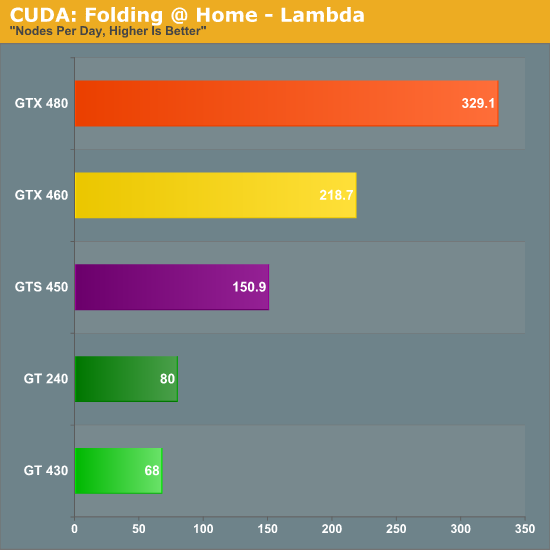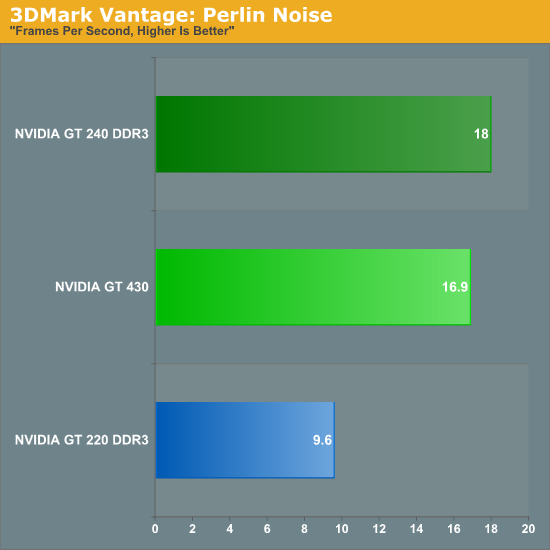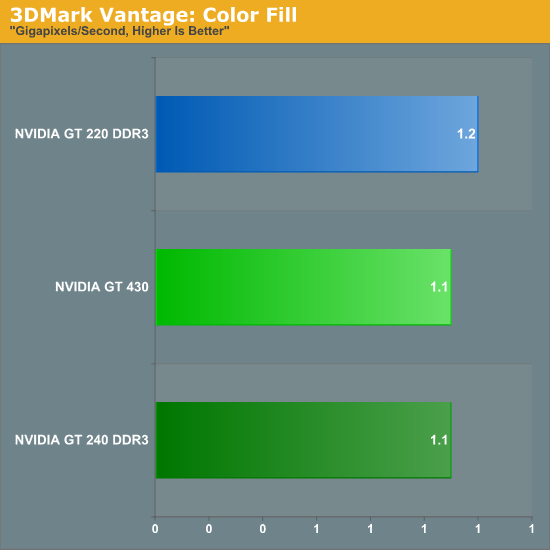NVIDIA's GeForce GT 430: The Next HTPC King?
by Ryan Smith & Ganesh T S on October 11, 2010 9:00 AM ESTCompute Performance & Synthetics
While the GT 430 isn’t meant to be a computing monster and you won’t see NVIDIA presenting it as such, it’s still a member of the Fermi family and possesses the family’s compute capabilities. This includes the Fermi cache structure, along with the 48 CUDA core SM that was introduced with GF104/GTX 460. This also means that it has a greater variation of performance than the past-generation NVIDIA cards; the need to extract ILP means the card performs between a 64 CUDA core card and a 96 CUDA core card depending on the application.
Meanwhile being based on the GF104 SM, the GT 430 is FP64 capable at 1/12th FP32 speeds (~20 GFLOPS FP64), a first for a card of this class.
For our look at compute performance we’ll turn to our trusty benchmark copy of Folding @ Home. We’ve also included the GT 240, a last-generation 96 CUDA core card just like the GT 430. This affords us an interesting opportunity to see the performance of Fermi compared to GT200 with the same number of CUDA cores in play, although GT 430 has a clockspeed advantage here that gives it a higher level of performance in theory.

The results are interesting, but also a bit distressing. GT 430’s performance as compared to the GTS 450’s performance is quite a bit lower, but this is expected. GT 240 however manages to pull ahead by nearly 17%, which is quite likely a manifestation of Fermi’s more variable performance. This makes the GT 220 comparison all the more appropriate, as if Fermi’s CUDA cores are weaker on average then GT 430 can’t hope to keep pace with GT 240.
To take a second look at CUDA core performance, we’ve also busted 3DMark Vantage out of the vault. As we’ve mentioned before we’re not huge fans of synthetic tests like 3DMark since they encourage non-useful driver optimizations for the benchmark instead of real games, but the purely synthetic tests do serve a useful purpose when trying to get to the bottom of certain performance situations.
We’ll start with the Perlin Noise test, which is supposed to be computationally bound, similar to Folding @ Home.

Once more we see the GT 430 come in behind the GT 240, even though the GT 430 has the theoretical advantage due to clockspeed. The loss isn’t nearly as great as it was under Folding @ Home, but this lends more credit to the theory that Fermi shaders are less efficient than GT21x CUDA cores. As a card for development GT 430 still has a number of advantages such as the aforementioned FP64 support and C++ support in CUDA, but if we were trying to use it as a workhorse card it looks like it wouldn’t be able to keep up with GT 240. Based on our gaming results earlier, this would seem to carry over to shader-bound games, too.
Moving on, we also used this opportunity to look at 3DMark Vantage’s color fill test, which is a ROP-bound test. With only 4 ROPs on the GT 430, this is the perfect synthetic test for seeing if having fewer ROPs really is an issue when we’re comparing GT 430 to older cards.

And the final verdict? A not very useful yes and no. GT 220 and GT 240 both have 8 ROPs, with GT 220 having the clockspeed advantage. This is why GT 220 ends up coming out ahead of GT 240 here by less than 100 MPixels/sec. But on the other hand, GT 430 has a clockspeed advantage of its own while possessing half the ROPs. The end result is that GT 430 is effectively tied with these previous-generation cards, which is actually quite a remarkable feat for having half the ROPs.
NVIDIA worked on making the Fermi ROPs more efficient and it has paid off by letting them use 4 ROPs to do what took 8 in the last generation. With this data in hand, NVIDIA’s position that 4 ROPs is enough is much more defensible, as they’re at least delivering last-generation ROP performance on a die not much larger than GT216 (GT 220). This doesn’t provide enough additional data to clarify whether the ROPs alone are the biggest culprit in the GT 430’s poor gaming performance, but it does mean that we can’t rule out less efficient shaders either.
Do note however that while Fermi ROPs are more efficient than GT21x ROPs, it’s only a saving grace when doing comparisons to past-generation architectures. GT 430 still only has ¼ the ROP power as GTS 450, which definitely hurts the card compared to its more expensive sibling.










120 Comments
View All Comments
duploxxx - Friday, October 15, 2010 - link
makes you wonder how good your IT qualities are.... had tons of ati and nvidia cards, never had issues with ati or nvidia. Sure both of them have had a few glitches but that is more due to MS and the drivers.btw it's often due to crappy OEM implementation of the vendor driver, ever thought of that????
dnd728 - Friday, October 15, 2010 - link
Another Einstein...Fallen Kell - Tuesday, October 12, 2010 - link
I bought a passive AMD 5750 which I use in my HTPC, mainly to gain Blu-Ray audio bitstreaming. I have to say, AMD still has a lot of work they need to do in terms of their drivers. As much as I love the capabilities of this card, I spent 5 days getting it to work properly and output the bitstreamed audio. I think that is probably a large reason why their market share hasn't grown. It should have just worked after I installed the latest drivers. But no, I had to download a specific version (not the latest), had to also download audio drivers from ANOTHER company entirely (not AMD), get a specific version of those drivers (not the latest), install them in the proper order (i.e. install the third party drivers after I installed AMD's drivers).... It was hoop after hoop after hoop.... A normal consumer would have simply taken the card back as "broken".khimera2000 - Thursday, October 14, 2010 - link
I had to change the default audio after the ATI drivers installed... it took me two minuts to get it working ;Dtherealnickdanger - Monday, October 11, 2010 - link
If image quality is so important, you wouldn't watch anything but 1080p24 Blu-Ray in the first place! :)But seriously, in the days of DVD, HQV tests were of higher importance because DVD was 480i, when the movies and television shows were typically sourced on film @ 24 fps. With Blu-Ray, you get to watch TV and film in the native cadence with no deinterlacing, and you certainly don't want resoution scaling or conversion of any kind. Any attempt to artificially smooth or sharpen the image would adversely affect image quality.
The most important feature to home theater enthusiasts is the purest representation of the original source, without enchancements or filters.
ganeshts - Monday, October 11, 2010 - link
I am sure there are plenty of HTPC users who shoot using camcorders like the Flip or the Playsport. Not all of those videos are in 60fps. 30 fps videos need to be 2:2 pulled-down. Cadence detection helps a lot here.In addition, Blu-Ray also allows 1080i videos. Of course, if you have a video processor, source direct is best. However, a good HTPC is supposed to make a video processor redundant.
We have mentioned in the review that power users can always work around the unimplemented features by doing a 'source direct' playback.
Stonedofmoo - Monday, October 11, 2010 - link
For me the only reason I was holding out for this card was to see how effective it would be as a dedicated PhysX card to use in conjunction with my GTX460 1Gb.The GTS450 seems rather overkill for just that task so I was hoping the GT430 would be the ideal cheap option..
Ryan Smith - Monday, October 11, 2010 - link
To be honest it's not something I had a chance to test. I've only had the card since Friday afternoon, so there wasn't much room for extras. I'll see if I can squeeze it in today.Stonedofmoo - Monday, October 11, 2010 - link
No worries, it would be interesting to see if it's any use for a dedicated PhysX card.Thanks for the review :-)
Snoopy_69__ - Monday, October 11, 2010 - link
Unless someone makes a fanless GT430